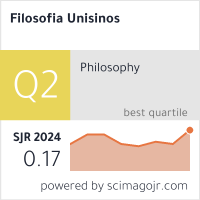Submissions
Submission Preparation Checklist
As part of the submission process, authors are required to check off their submission's compliance with all of the following items, and submissions may be returned to authors that do not adhere to these guidelines.-
The work is original and unpublished and it is not under consideration for publication anywhere else.
-
The manuscript file is in Microsoft Word or RTF format.
-
The original text must contain in the following order:
- Title: in the same language of the article, and in English. The titles (on the original language and English) must have a maximum of 240 characters including spaces.;
- Abstract: in the language of the article and in English with no more than 200 words, followed by at least three key-words;
- Full text: typed in Times New Roman format, font 12, and with spacing of 1,5.
- Images: In case the article contains photographic images and/or graphic drawings, those must be submitted in original format (.jpeg, .png, .tiff, .xls, .xlsx) and in separated files (not inserted in the text). Images (.jpeg, .png, .tiff) must have a with minimal resolution of 300 dpi. Authors must indicate by the insertion of captions (on the original language and in English too) where approximately the pictures should be inserted.
- Citing authors: in-text citation must follow the 'author, year' format [E.g. (Leipnitz, 1987); (Turner e Verhoogen, 1960); (Amaral et al., 1966)].
-
The identification of authorship of the work has been removed from the file, ensuring the journal's confidentiality criteria, if the manuscript is subjected to peer review (e.g. articles), according to instructions in Ensuring a Blind Peer Review.
-
- Short quotations (containing less than three lines) must be incorporated into the text in quotation marks.
- Long quotations (longer than three lines) must be presented in an isolated paragraph, with simple spacing, font size 11 and the left margin larger than the surrounding text (4cm).
-
- Footnotes must be used only when strictly necessary for information that is complementary to the text. Footnotes containing only references are not allowed. These must be listed in the end of article, in the 'References' item.
- Book Reviews should contain no footnotes.
-
The manuscript is in accordance to the style and bibliographic requirements described in the Author's Guideline section.
-
The list of references must include only works that are cited in the text. Reference list entries must be in alphabetical order at the end of the text.
References must be typed in Times New Roman (pt 12) and single spacing between lines.
See examples of references HERE.
Articles
Insira aqui a política desta seçãoPhilosophical notes
Copyright Notice
I grant the Filosofia Unisinos – Unisinos Journal of Philosophy the first publication of my article, licensed under Creative Commons Attribution license (which allows sharing of work, recognition of authorship and initial publication in this journal).
I confirm that my article is not being submitted to another publication and has not been published in its entirely on another journal. I take full responsibility for its originality and I will also claim responsibility for charges from claims by third parties concerning the authorship of the article.
I also agree that the manuscript will be submitted according to the UJP’s publication rules described above.
Privacy Statement
The names and email addresses registered in this journal will be used exclusively for the services provided by this publication and will not be available for other purposes or to third parties.










